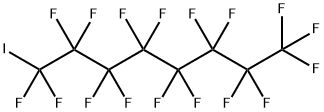Research advance of perfluorooctyl Iodide
Introduction
Production of perfluorooctyl iodide [PFOI (Figure 1)] has increased in recent years because of its great commercial value. Studies have shown that the concentration of perfluorooctyl iodide is relatively higher in the air and soil than the concentrations of the other derivatives of perfluorinated iodine alkanes (PFIs).

1. Perfluorooctyl Iodide Stimulates Steroidogenesis in H295R Cells via a Cyclic Adenosine Monophosphate Signaling Pathway
Perfluorinated iodine alkanes (PFIs) are used widely in the organic fluorine industry. Increased production of PFIs has caused environmental health concerns. To evaluate the potential endocrine-disrupting effect of PFIs, we investigated the effects of perfluorooctyl iodide (PFOI) on steroidogenesis in human adrenocortical carcinoma cells (H295R). Levels of aldosterone, cortisol, 17β-estradiol, and testosterone were measured in H295R culture medium upon treatment with perfluorooctanoic acid (PFOA) and PFIs. Expression of 10 steroidogenic genes (StAR, HMGR, CYP11A1, 3βHSD2, 17βHSD, CYP17, CYP21, CYP11B1, CYP11B2, and CYP19) was measured by real-time polymerase chain reaction. Levels of cyclic adenosine monophosphate (cAMP) and adenylate cyclase (AC) activity were measured to understand the underlying mechanism of steroidogenic perturbations. Levels of production of aldosterone, cortisol, and 17β-estradiol were elevated significantly, and the level of testosterone generation decreased upon treatment with 100 μM perfluorooctyl iodide. Similar to the effect induced by forskolin (AC activator), expression of all 10 genes involved in the synthesis of steroid hormones was upregulated significantly upon exposure to 100 μM perfluorooctyl iodide. PFOA had no effect on steroid hormone production or steroidogenic gene expression even though it is highly structurally similar with perfluorooctyl iodide. Therefore, the terminal-CF2I group in perfluorooctyl iodide could be a critical factor for mediation of steroidogenesis. Perfluorooctyl iodide increased AC activity and cAMP levels in H295R cells, which implied an underlying mechanism for the disturbance of steroidogenesis. These data suggest that perfluorooctyl iodide may act as an AC activator, thereby stimulating steroidogenesis by activating a cAMP signaling pathway.[1]
2. Estrogen-like Response of Perfluorooctyl iodide in Male Medaka (Oryzias latipes) Based on Hepatic Vitellogenin Induction
This study demonstrates that perfluorooctyl iodide causes significant upregulation of estrogenic responsive genes like ERs and VTGs in the liver of adult male medaka. Likewise, the synthesis of hepatic VTG protein is also detected. This study provided important information on the endocrine disrupting effects of perfluorooctyl iodide, offering a tool for the evaluation of toxicities of PFCs using medaka fish model, which helps to discover the potential toxicities and underlying mechanisms of new PFCs. During this study, the estrogenic effects of perfluorooctyl iodide were characterized by the combinations of estrogenic-related endpoints. First, the changes of important estrogenic responsible genes such as ERs, VTGs after short time exposure were accessed using RT-PCR. Three ERs, (ERa, ERb, ERc) have been identified in teleosts. Abnormal induction of ERs in male or immature fish may have adverse consequences. In different fish species, the different ERs do not equally contribute to gene transcription of VTG. In most cases, estrogen-like chemicals can bind to their specific ERs, acting as ligand-activated transcription factors to promote estrogen target gene expression and then the corresponding VTG protein was synthesized.
This study demonstrates that perfluorooctyl iodide induce the expression of ERs, VTGs, and hepatic VTG protein synthesis, but the underlying mechanism and the toxicological consequences remain unclear. No information is currently available on the estrogenic effects of other kinds of FIAs or the combinations of different FIAs. Furthermore, the level of perfluorooctyl iodide in aquatic environment hasn't been reported although previous reports verified the presence of four FIAs in the troposphere. [2]
3.The toxic effects of perfluorooctyl iodide and its regulation of longchain non-coding RNA MALAT-1
Another research results showed that the migration ability of MCF-7 cells was improved after perfluorooctyl iodide exposure, and the high expression of MALAT-1 gene was induced in MCF-7 cells. In vivo, perfluorooctyl iodide (50 μmol/L and 100 μmol/L) exposure resulted in delayed embryonic development, and the spontaneous movement of zebrafish embryos became more active because they were not controlled by neuroregulation. The hatching rate of zebrafish embryos was significantly decreased in the group exposed to perfluorooctyl iodide (50 μmol/L and 100 μmol/L) . It also induced the upregulation of MALAT-1 gene in the brain of zebrafish larvae. These results suggest that MALAT-1 is involved in the regulation of toxic effects such as cell migration and spontaneous hyperactivity induced by perfluorooctyl iodide.[3]
References
[1]Wang C, Ruan T, Liu J, He B, Zhou Q, Jiang G. Perfluorooctyl Iodide Stimulates Steroidogenesis in H295R Cells via a Cyclic Adenosine Monophosphate Signaling Pathway. Chem Res Toxicol. 2015;28(5):848-854. doi:10.1021/tx5004563
[2]Wang Y, Zhou Q, Wang C, et al. Estrogen-like response of perfluorooctyl iodide in male medaka (Oryzias latipes) based on hepatic vitellogenin induction. Environ Toxicol. 2013;28(10):571-578. doi:10.1002/tox.20751
[3]Yang X, Song F, Peng L,et al. The toxic effects of 1-iodoperfluorooctane and its regulation of long-chain non-coding RNA MALAT-1[J]. Asian Journal of Ecotoxicology,2020,15(4) : 149-157
You may like
Lastest Price from Perfluorooctyl iodide manufacturers

US $0.00/kg2025-04-10
- CAS:
- 507-63-1
- Min. Order:
- 1kg
- Purity:
- 99%
- Supply Ability:
- 20 tons

US $0.00-0.00/kg2025-04-04
- CAS:
- 507-63-1
- Min. Order:
- 1kg
- Purity:
- 98%
- Supply Ability:
- 1Ton


